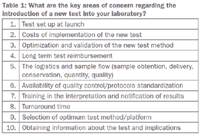Early Engagement with Medical Laboratories
Pharmaceutical Executive
Timely engagement is the key to expanding the use of companion diagnostics.
Personalized medicine has been described as a disruptive force in healthcare, but at this early stage of its development it looks more like a collection of disconnected building sites than a trajectory for healthcare transformation. Discussions abound around the $1,000 genome profile, new regulations, new reimbursement codes, deals between Big Pharma and diagnostic makers, and targeted therapy launches. Companies with the right vantage point have determined that leveraging diagnostics to develop drugs faster, for the right patient, is an idea whose time has come.
How disruptive the endpoint will be depends on how Big Pharma embraces the arrival of new stakeholders who have been neglected in the rough and tumble, competitive climate of healthcare delivery. One of the neglected stakeholder groups that will become increasingly central to personalized medicine is the medical laboratory. It is the laboratory—not the diagnostics manufacturers—which sits at the confluence of the flow of new tests, policies, and clinical insights; it is the laboratory which sits side-by-side with the physician community as it struggles to embrace all this new information about a patient's biology. Indeed it is the laboratory rather than the diagnostic industry which pharma should turn to in prioritizing its future partnering activities. The declaration sounds counter-intuitive. Why is this?
Labs lead
One of the least highlighted aspects of laboratory medicine is the fact that, due to its proximity to patient samples and the analytical infrastructure involved in the conduct of clinical trials, they have an enormous capacity for discovery and innovation. Many of the biomarkers we consider today as pillars of targeted treatment in oncology were discovered, not by diagnostic or pharmaceutical companies, but by laboratories situated very close to the patients and physicians themselves. Take, for example, the work of Stanley Cohen, PhD, whose career started in 1959 as assistant professor of biochemistry at Vanderbilt University. Cohen discovered, isolated, purified, and sequenced epidermal growth factor (EGF), a protein that stimulates the growth of epithelial and other cells and enhances certain developmental growth cascades. Once the sequence was known, he was able to identify the target receptor for EGF and the mechanism of its action, providing a breakthrough in understanding how signals from outside a cell reach the inside of a cell.
Similarly, the anaplastic lymphoma kinase (ALK) gene was discovered by scientists from St. Jude Children's Research Hospital, while searching for certain chromosomal changes in genes often seen in cancer cells of patients with anaplastic large cell lymphoma (ALCL). Stephan Morris, Thomas Look, and their colleagues published the first reports detailing the discovery of ALK in 1994. Several adult and childhood cancers, including ALCL and neuroblastoma (a childhood nerve cell tumor), are now considered to be triggered by the ALK gene. Pfizer, through the St. Jude Hospital Office of Technology Licensing, has been granted licences to access the research tools patented by the hospital, from which the drug maker was able to obtain approval and launch Xalkori, indicated for treatment of non-small cell lung cancer (NSCLC).
As companion testing becomes more complex we will need to rely on these same innovation skills as laboratories install testing algorithms that might see panels of 10 or more biomarkers being used to guide a treatment decision in NSCLC or breast cancer or diabetes. While Big Pharma is familiar with the role that clinical investigators play in testing new therapies, only the laboratory manager is in a position to interpret their conclusions and suggest realistic alternatives that serve the needs of individual patients.
Joining the dots
In a broader sense, personalized medicine is far too complex to implement without active collaboration of many stakeholders, including the laboratory. Even if a physician has been sufficiently educated about the testing options, and has decided that a specific targeted therapy should be considered, he or she may need a rapid turnaround on a prerequisite test or multiple tests as well as guidance on the best way to interpret the results. The clinical journey may be further frustrated by difficulties ranging from obtaining informed consent from the patient to genetic testing and agreement on pathology or molecular standard samplings, while on the other side there is the growing concern that the laboratory may not, under current standards, be receiving adequate reimbursement for running and analyzing test results. There are a host of concerns too when a new test is introduced without prior consultation with the laboratory staff. Taken together, these factors tend to conspire to slow the availability of "the right test, at the right time."
Such complexities are not going to be resolved by technology suppliers but rather laboratories all over the world working to get a test result back into the hands of a physician seeking to make a treatment decision. Understanding these impediments and collaborating in their timely resolution will ensure the targeted treatment is seamless—and works for all parties involved in the delivery of care.
Despite the significant role that laboratories can play in personalized medicine, our research indicates that few of the industrial partners who rely on external laboratories to run companion diagnostic testing pay them any mind. Our laboratory services company, Labceutics, conducted a Delphi study between November 2011 and January 2012 covering a network of 160 laboratories across five European Union countries (France, Germany, Italy, the United Kingdom, and Spain) to determine what are the most critical barriers to realizing more effective deployment of companion biomarkers in personalized medicine. Responses were gathered and analyzed from 31 of those 160 laboratories, across five the countries.
The findings indicated that very few pharmaceutical companies seeking to launch a new test and treatment protocol ever engage with these laboratories, despite their clear importance in the front line of treatment for patients. The results also provide a hierarchy of issues between Big Pharma and the laboratory community that, if left unresolved, will impede further progress in integrating diagnostics as an essential element in personalized medical care.
Benefits of proactive engagement
A key conclusion is that laboratories need more time to prepare for the effective introduction of novel tests, with 40 percent of laboratories indicating that it took between seven to 12 months to fully implement a new test and a further 25 percent indicating their belief that they could make a new test available in three to six months. These lag times required to prepare for the introduction of these novel tests are not recognized by the pharmaceutical industry today, which opens up the very real risk that the demand for a therapy will be held back by the lack of a readily available test to a physician.
Feedback from laboratories also revealed (see Table 1) that there are ten key areas of primary concern when introducing a new test, all of which required additional investment of time and expense on their part.

Table 1: What are the key areas of concern regarding the introduction of a new test into your laboratory?
An area of concern highlighted by the Delphi survey was the apparent preference by laboratory managers for LDTs versus the purchase of an IVD kit, as shown in Table 2. The majority of laboratories (48 percent) responded that their decision on which type of test to use depended upon the frequency of demand (utilization) for the test, with only 23 percent of laboratories indicating that a first preference would be the purchase of a kit.

Table 2: What is your preference when introducing a new diagnostic?
The simple fact is that the medical laboratory, much more than the diagnostic company, is located at the single most influential junction point in the supply chain for companion testing within the field of personalized medicine. The laboratory is best placed to diffuse high quality testing, help educate physicians on biomarker choices, and deliver superior service around analysis, interpretation, and turnaround time. We conclude that a greater understanding of the current impediments to implementing companion testing and recognition of the laboratories' future role in evolving personalized medicine as a benefit to patients is urgently required from Big Pharma development and commercialization teams seeking to launch novel targeted therapies.

Peter Keeling is CEO of the Diaceutics Group, a business software firm specializing in personalized medicine. He can be reached at peter.keeling@diaceutics.com. Maria Fe Paz is Managing Director of the Labceutics Division of the Diaceutics Group.

The Misinformation Maze: Navigating Public Health in the Digital Age
March 11th 2025Jennifer Butler, chief commercial officer of Pleio, discusses misinformation's threat to public health, where patients are turning for trustworthy health information, the industry's pivot to peer-to-patient strategies to educate patients, and more.
Navigating Distrust: Pharma in the Age of Social Media
February 18th 2025Ian Baer, Founder and CEO of Sooth, discusses how the growing distrust in social media will impact industry marketing strategies and the relationships between pharmaceutical companies and the patients they aim to serve. He also explains dark social, how to combat misinformation, closing the trust gap, and more.